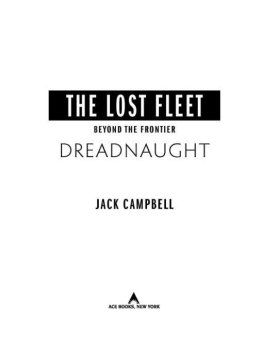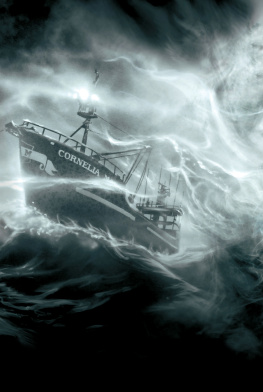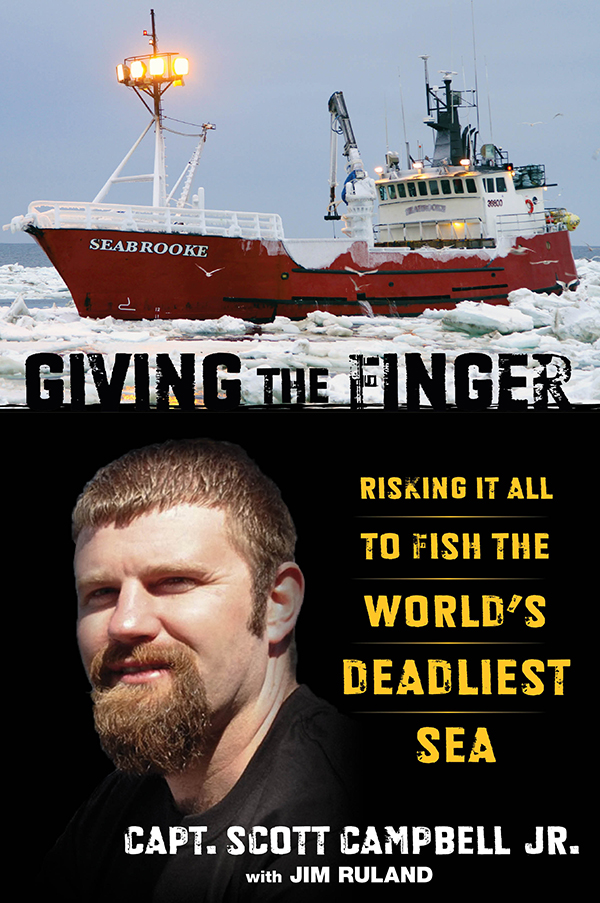Giving the Finger
Giving the Finger
Risking It All to Fish the Worlds Deadliest Sea
Scott Campbell Jr.
with Jim Ruland
LYONS PRESS
Guilford, Connecticut
An imprint of Globe Pequot Press
Copyright 2014 by Seabrooke Holdings, LLC
ALL RIGHTS RESERVED. No part of this book may be reproduced or transmitted in any form by any means, electronic or mechanical, including photocopying and recording, or by any information storage and retrieval system, except as may be expressly permitted in writing from the publisher. Requests for permission should be addressed to Globe Pequot Press, Attn: Rights and Permissions Department, P.O. Box 480, Guilford, CT 06437.
Lyons Press is an imprint of Globe Pequot Press.
All photos are by the author or are part of the authors collection.
Text Design: Sheryl P. Kober
Layout artist: Justin Marciano
Project editor: Ellen Urban
Library of Congress Cataloging-in-Publication Data is available on file.
ISBN 978-1-4930-0804-9
Dedicated to Keith Criner, aka Moose, and his family.

Contents
CHAPTER ONE
DEAD IN THE WATER
Honey, I had a little bit of an accident.
I was sitting in the galley of the Amatuli in the middle of the Bering Sea during a ferocious winter storm. Talking on the satellite phone with my wife, I looked down at the ring finger on my right hand.
Or what was left of my ring finger.
What happened? Lisa asked.
She probably figured that if I was calling her on the phone during crab season, it had to be serious. It was serious, but I didnt want her to know that.
Oh, I hurt my finger.
What did you do?
I banged it up a little bit. I explained how Id smashed my finger down in the engine room, and that it wasnt too bad, just the tip of my finger really.
You mean like around the nail?
Yeah, I said. Like that.
But it was more than that. A lot more.
The nail was gone. So was the flesh around it.
The only thing left was the bone sticking out of my finger.
And blood. Lots and lots of blood.
The fingers of the human hand, I would soon learn, are made up of three distinct parts called phalanxes: the proximal, middle, and distal. The proximal phalanx is where the finger attaches to the hand. The distal is the tip. So, technically, I wasnt lying to my wife when I told her that Id hurt the tip of my finger. But the distal phalanx was more than hurt. It was missing. All the way down to the knuckle. Just gone.
Lisa was a nurse. She knew all the medical mumbo jumbo. But if she knew what I knew, could see the mess that I was looking at, shed make me come home, which Id already decided I didnt want to do.
Scott, what happened?
Good question.
The strike happened. The ice happened. The shitty air compressor on the shitty Amatuli happened. All the things that can go wrong when you go crab fishing on the Bering Sea happened.
Id been around crab boats all my life, but this was my first time running one professionally. Id been fishing with my father and my uncle from the time I was fifteen years old and around boats in one way or another since I was four. The sea was in me, a part of who I was, but for the first time in my life, I was the captain. My crew. My boat. Id finally stepped out of my fathers shadow, and now it was my reputation that was on the line. I had a lot of pressure on me, and I was ready for the challengeat least I thought I was. But my mangled hand told a different story.
The Amatuli was a crappy old junker, long and skinny with a house aft instead of forward and a tendency to roll. She wasnt designed for extreme weather. In fact she had no business being up there in the Bering Seas blisteringly cold cauldron.
The Amatuli was the type of boat you got when you were first starting out. They dont give young guys new boats and a half a million dollars worth of gear and say, Go catch some crab! You have to earn it.
When the owner of the Amatuli asked me to skipper his boat in 2000, it was up to me to hire the crew. I called every fisherman Id ever worked with and begged him to give me a chance. You know what I can do on deck, I told each one of them. Ill do the same thing in the wheelhouse. But I gotta have a good crew to make it happen.
Though skeptical at first, one by one they came around. Eventually I was able to convince enough guys to put together a halfway decent crew. My best crewman was Jerry Perkey, a longtime friend and super-skilled deckhand who had an offbeat sense of humor. A dependable guy. He even saved my life once.
I was able to fill all the positions on the boat except one. I couldnt find an engineer to help keep the boat running smoothly while I focused on fishing. I decided that Id serve as my own. It wasnt an ideal situation, but I didnt have many options.
My strategy that season was to fish with two loads of gear. Wed leave one set of crab pots in the water as an underwater storage, come back to port, and get the second set on deck. Then, once the season started, wed go back out to the fishing grounds, set the second set of pots, and start hauling the first set.
Double the work. Double the reward.
The crew assembled in Dutch Harbor, Alaska, where the Amatuli was waiting for us to make her seaworthy. But she was in much worse shape than I thought. We spent a ton of time doing basic maintenance on the boat, things that hadnt been done in who knows how long. When we went out to sea to put our first set of gear in the water, I discovered how unstable she was.
She was always breaking down. Id set a string, and something would go wrong. Set another string, and something else would fail. I could hardly get anything done, because the boat was constantly falling apart on me. Ive always been handy with engines, so I was able to patch it together, but without an engineer on board, I spent as much time in the engine room as I did in the wheelhouse.
When we got back to Dutch Harbor, I received word that negotiations with the canneries were underway. That meant that a strike was coming. Strikes were a fairly common occurrence back then. If the fishermen didnt like the price the canneries were offering, wed stand down and try to get a better deal. Normally a strike lasted a few days. This one lasted three weeks.
There I was, my first crack at being a captain, and I had to stand down for almost a month waiting for my opportunity.
And then the ice started coming down.
The sea ice forms in the northern part of the Bering Sea and gets blown southward. The ice is as much a part of the sea as the wind and the waves, but you cant fish in it, and you sure as hell cant leave your gear in it.
I had a quarter of a million dollars worth of gear in the water that was going to get lost to the ice, which would make the owner of the Amatuli very unhappy. There was no choice but to take my second load of gear off the Amatuli, go back up to the fishing grounds, and try to get the gear out before the ice did.
Some people might say, Relax. Its out of your control. But thats not me. I was mad at myself. Id underestimated how long the strike would last and miscalculated how far the ice would come down. Id made two costly errors in judgment, and we hadnt even started fishing yet.
How many more mistakes could I afford to make?
Answer: none.











